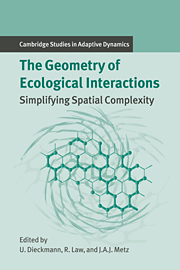Book contents
- Frontmatter
- Contents
- Contributing Authors
- 1 Introduction
- Part A Empirical and Statistical Background: A Plant Ecological Perspective
- Part B When the Mean-field Approximation Breaks Down
- Part C Simplifying Spatial Complexity: Examples
- Part D Simplifying Spatial Complexity: Techniques
- Introduction to Part D
- 18 Pair Approximations for Lattice-based Ecological Models
- 19 Pair Approximations for Different Spatial Geometries
- 20 Moment Methods for Ecological Processes in Continuous Space
- 21 Relaxation Projections and the Method of Moments
- 22 Methods for Reaction–Diffusion Models
- 23 The Dynamics of Invasion Waves
- 24 Epilogue
- References
- Index
- International Institute for Applied Systems Analysis
18 - Pair Approximations for Lattice-based Ecological Models
Published online by Cambridge University Press: 14 January 2010
- Frontmatter
- Contents
- Contributing Authors
- 1 Introduction
- Part A Empirical and Statistical Background: A Plant Ecological Perspective
- Part B When the Mean-field Approximation Breaks Down
- Part C Simplifying Spatial Complexity: Examples
- Part D Simplifying Spatial Complexity: Techniques
- Introduction to Part D
- 18 Pair Approximations for Lattice-based Ecological Models
- 19 Pair Approximations for Different Spatial Geometries
- 20 Moment Methods for Ecological Processes in Continuous Space
- 21 Relaxation Projections and the Method of Moments
- 22 Methods for Reaction–Diffusion Models
- 23 The Dynamics of Invasion Waves
- 24 Epilogue
- References
- Index
- International Institute for Applied Systems Analysis
Summary
Introduction
In recent years, the effects of spatial configuration on population and evolutionary processes have been the subject of intensive research efforts in ecology and evolutionary biology. One reason for this surge of interest is the observation of intricate, natural spatio-temporal structures. Such structures are exemplified, for instance, by wave regeneration of fir forests, in which trees show a large-scale, wavelike pattern of regeneration with many stripes of dieback zones moving slowly downwind at a constant rate (Iwasa et al. 1991; Satō and Iwasa 1993; Jeltsch and Wissel 1994). Another example of spatio-temporal structure studied in forest ecology is the formation and closure of canopy gaps (Kubo et al. 1996; see Chapter 13). It is now acknowledged that considering spatio-temporal structures spontaneously formed by demographic processes and ecological interactions is sometimes essential for understanding population and evolutionary dynamics, and that traditional modeling in theoretical ecology assuming complete spatial mixing often fails to capture these dynamics.
A simple and useful method for modeling population and evolutionary dynamics in a spatially explicit way is to use a lattice, or cellular automaton, model. Typically, one considers a large regular lattice, which may be linear, square, hexagonal, or triangular, in which an individual occupies one vertex, or lattice site. We assume that each individual interacts directly and strongly only with its nearest neighbors. Most ecological interactions between individuals – for example, competition for resources, disease transmission, cooperative interaction such as attracting common pollinators, and reproduction – occur at spatial scales much smaller than that of the whole population.
- Type
- Chapter
- Information
- The Geometry of Ecological InteractionsSimplifying Spatial Complexity, pp. 341 - 358Publisher: Cambridge University PressPrint publication year: 2000
- 17
- Cited by



